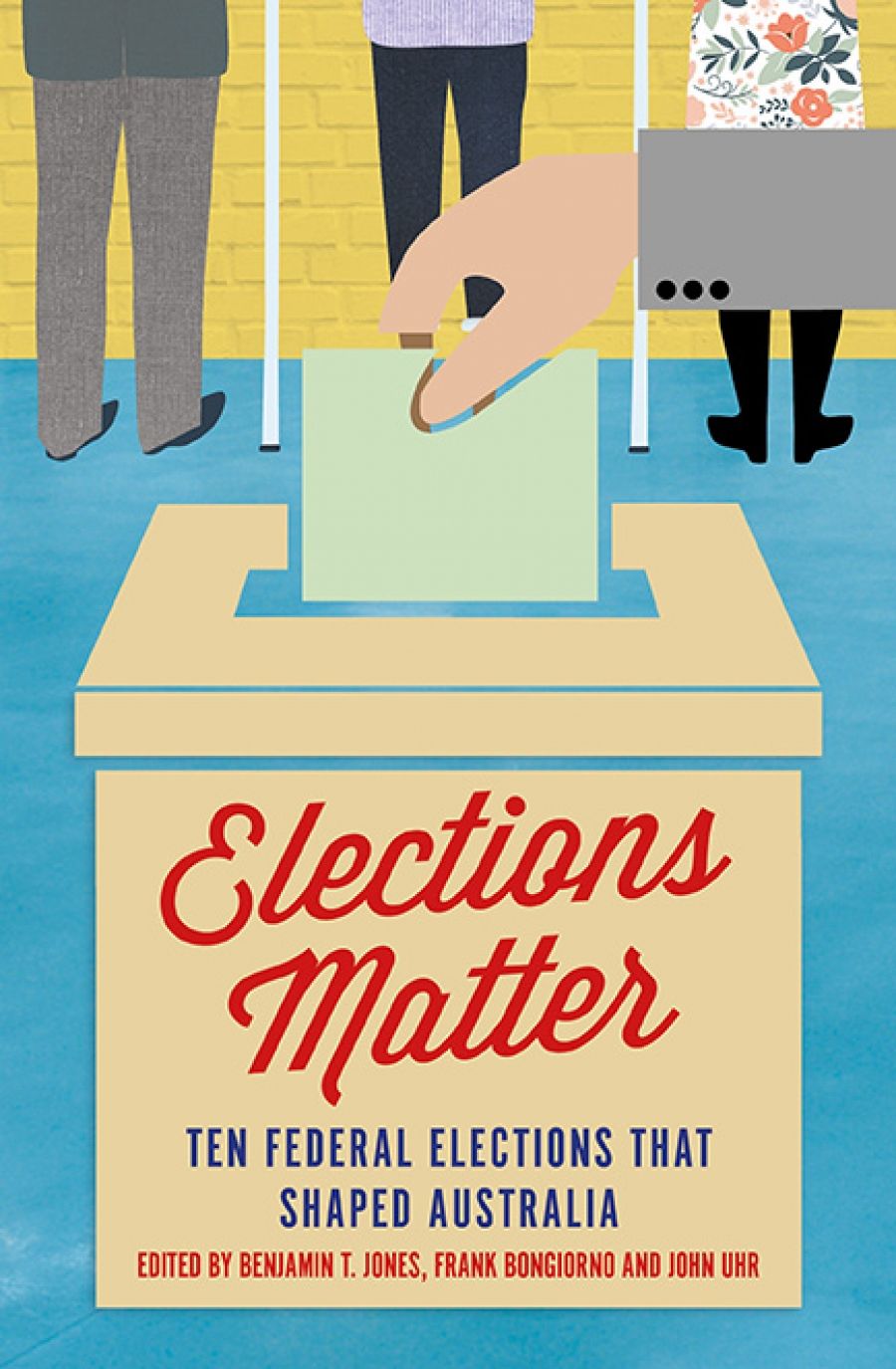
- Free Article: No
- Contents Category: Politics
- Custom Article Title: Lyndon Megarrity reviews <em>Elections Matter</em> edited by Benjamin T. Jones, Frank Bongiorno, and John Uhr
- Custom Highlight Text:
The atmosphere among Australian electors lining up to cast a vote at a school, hall, or similar institution is generally relaxed and informal, a ‘vibe’ enhanced by the friendly banter of local party members handing out ‘How to Vote’ cards. But the casualness of the Australian way of voting cannot ...
- Book 1 Title: Elections Matter: Ten federal elections that shaped Australia
- Book 1 Biblio: Monash University Publishing, $29.95 pb, 294 pp, 9781925523157
Many readers will be surprised that some key federal elections did not merit inclusion in this volume. The 1949 election leading to the Menzies era, the 1975 poll in the wake of the Dismissal, and Bob Hawke’s first victory in 1983 are conspicuous by their absence. Instead, the book is marked by analysis of less commemorated electoral contests, which, as the authors point out, are more historically significant than one might assume.
Elections that consolidate policies and political perceptions are prominently featured. Richard Reid’s focus on the 1969 poll highlights the fact that although the ALP did not win, their strong showing under the modern leadership of Gough Whitlam reflected, without a doubt, that Labor was back from the electoral wilderness of just a few years before. Elsewhere, Frank Bongiorno argues convincingly that it was the 1987 election that ‘bedded down’ the Hawke–Keating policy mixture of dry economics, a social safety net, and ambitious policy initiatives. The electoral result was a partial rejection of the even more doctrinaire economic focus of the Howard Liberals and confirmed the electoral preference for a ‘middle way’ in public life.
Understandably, the role of the prime minister as the ultimate representative of an incumbent government is emphasised in most essays included in this collection. Alex Millmow provides an entertaining portrait of Stanley Melbourne Bruce, that most British of Australian prime ministers, whose over-confidence in 1929 led him to make electorally unwise decisions, such as the introduction of an ‘amusement tax of five per cent imposed on the gross receipts of all theatre and entertainment’. Isobelle Barrett Meyering’s chapter on the 2010 election is notable for its thoughtful treatment of the politics of gender, which has become so prominent within the public sphere. The author includes discussion of then Opposition Leader Tony Abbott’s attempts to change his ‘hypermasculine’ image in various ways, including public acknowledgment of the ‘strong women’ in his life such as his wife and his daughters.
 Australian Prime Minister Paul Keating shakes hands with Opposition Leader John Howard before a live debate with mediator Ray Martin in Sydney, February 25, 1996.
Australian Prime Minister Paul Keating shakes hands with Opposition Leader John Howard before a live debate with mediator Ray Martin in Sydney, February 25, 1996.
Jill Sheppard provides a sound analysis of the 1996 election in which John Howard’s Liberal–National Party Coalition defeated Paul Keating’s government. The author is on sure ground when she implies that a majority of voters in that year responded more positively to Howard’s rhetorical emphasis on pre-serving Australia’s social fabric than to Keating’s focus on social change. However, Sheppard contentiously states that ‘Keating’s ALP had promised a new vision for Australia: a confident, outward-looking socially progressive national identity’. Clearly, such a stance was by no means novel: Whitlam in the 1960s and 1970s was a key exponent of such a vision. Further, the Keating ALP’s ‘big picture’ ideas were often built on the work of previous govern-ments in areas such as multiculturalism, Australia’s relations with Asia, and Aboriginal affairs.
The general tone of Elections Matter implicitly celebrates and values the collective will of the electorate: there is even a useful appendix on the evolution of electoral processes and administration by Michael Maley, formerly of the Australian Electoral Commission. Nevertheless, some essays could have paid more attention to acknowledging the fact that, in many instances, major political and policy shifts are forced through without reference to the electorate, including savage budget cuts, replacements of prime ministers, and restructuring public services. Election results have frequently been manipulated by governments to claim somewhat spurious mandates for their ideological hobbyhorses. If the electorate is as conservative as the elections covered in this book often suggest, perhaps it is because caution at election time is the only potent protest against imposed societal changes.
These observations notwithstanding, Elections Matter has much to commend it. Each chapter is highly readable and showcases high standards of historical scholarship. Discussions of electoral processes and political campaigning are generally balanced by the contributors with biographical and historical context, which helps the general reader care about each individual election. It will serve as an effective reference work for political science students and for readers interested in the development of the Australian style of politics and democracy.


Comments powered by CComment